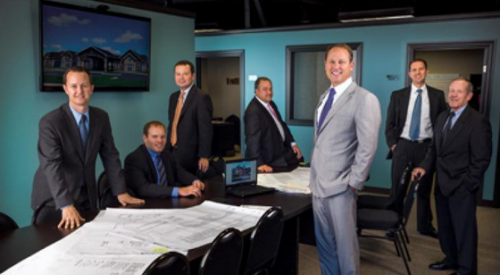|
It’s hard to imagine a retiree with more influence on the direction of production home building management methods than Jack Robinson. If you’re surveying buyers to discover what makes them tick or working to improve consistency in work flows, you are under Jack Robinson’s spell, even if you’ve never heard his name.
Robinson first made headlines as the driving force behind the radical management methods that lifted Rayco — 1980 Builder of the Year Ray Ellison’s old San Antonio production building dynamo — out of the late-1980s Texas market meltdown to mid-1990s levels of efficiency and profitability never before seen in this industry.
In 1985, Rayco had 3,265 sales in a San Antonio market that totaled only 7,058. But the Texas market maelstrom destroyed that empire. The company netted minus nine sales in October 1987 and teetered on the edge of bankruptcy a year later with 300 employees, down from 1,100. But by 1996, when Rayco won a National Housing Quality Award, the firm sold 2,600 detached homes, with market share above 50%, before-tax profits running at 12%, return on equity of 70% and a 35% return on assets. Jack Robinson led that turnaround.
That same year, Rayco was sold to Kaufman and Broad Inc. Robinson officially retired to his yacht, but actually stayed around for a while as a consultant to K&B. Since then, builders across the country have been picking at pieces of the Rayco model, trying to duplicate the success. Few have come close.
To set the industry on a more productive course, it’s time to recognize Robinson with a PB Achievement Award for developing that Rayco management model and to call attention to the fact that many builders are making mistakes by trying to apply parts of it ad hoc. As Robinson says, “To succeed with this system, you’ve got to do the whole thing.”
Even flow — a term Robinson hates — is a concept production builders throughout the industry talk about constantly. But few understand that regularized production on the construction site is only one piece of the puzzle. The Rayco model begins with consumer research. You have to know what people want to put their money into to get the product right.
| Management Innovation: Jack Robinson |
Robinson, who now is a consultant to a few builders, says you need to survey everyone in the market who buys a home — new or used — two to three months after closing. To get detailed information on the important trade-offs purchasers made, Rayco mailed nine-page questionnaires to every buyer in Bexar County, Texas. “All of the measures are done with buyers after closing,” Robinson says. “If you survey shoppers and build the house they want, they won’t be able to afford it or won’t want to buy it at the price you quote.”
All the questions deal with buying behavior — how people choose to spend their money. Robinson faults many builders for some of the questions they ask on surveys. “Don’t ask questions if you can’t do anything with the answer,” he says. “For instance, why ask about their age? What can you do with that?”
Instead, the Rayco model calls for gathering information about behavior and motivation, pointed questions that do not require assumptions to interpret. Rayco achieved a 28% response rate to its questionnaires and stayed stubbornly single-minded about trusting no one other than those buyers to make decisions about product, features and components. Robinson says those answers lead to the same place in every market, not just in San Antonio.
“It always comes down to more square footage for the money,” he says. “Not cubic footage. You can’t put more babies and furniture in vertical space.” Rayco’s houses were mostly two-story boxes with 8-foot ceilings, and that’s where the model still leads, he says.
Buyers do want to vary options and upgrades, Robinson says, “so you want to develop a carefully crafted options package and let them choose how they want to spend their money.”
Robinson led Rayco to build the first large-scale selection showroom in the early 1990s. By 1996, the company was operating a 15,000-square-foot center where buyers made all their after-sale selections. Many of the choices buyers make surprise builders. For instance, Rayco found that only 30% wanted fireplaces and less than 3% chose to purchase a built-in microwave oven.
“Buyers will fool you a lot when you ask them to vote with their own money,” Robinson says. “For instance, we found that buyers of lower-priced homes would often take the best lighting fixtures we offered, but upper-end buyers would often elect not to buy fixtures at all.”
Showrooms, design centers and selection studios now dot the landscape from coast to coast, but Robinson abhors the way most builders turn the concept away from his intent. “They make them into profit centers, to push margins by selling upgrades on commission,” he says. “The design center should be there to help us sell more houses by making the process easier for buyers.”
Rayco’s showroom demonstrated products and helped buyers make choices, but the options and upgrades carried the same markup as the house, never higher. And the employees were salaried, not on commission, charged solely with satisfying customers. “We had a lot of buyers who went to the showroom and didn’t choose a single upgrade,” Robinson says, “but they went back to their salesperson and bought a bigger house instead.”
Sales drive the entire Rayco model. Surveys and showrooms lead to products that maximize buyer perceptions of value and build sales velocity in every location. That allowed Rayco to build a backlog that permitted the firm to regularize not just construction but every element of work. Focus on continuous improvement of all those work processes then allowed Rayco to further improve the value equation in its sales centers and showroom.
“How can you regularize production without a sales backlog?” Robinson asks. “First we want to find the value the buyers seek, then we produce homes that dominate the market to such an extent that we can pre-sell 100% of production [no spec houses]. At Rayco, we always wanted to sell 40% more than we started, to maintain a backlog. If you have the best value equation, buyers will wait six to nine months to get exactly the house they want to pay for.”
That brings us to the drumbeat, what some builders call even flow. Robinson organized Rayco around the requirement that 10 houses a day would be sold, started, completed and closed every working day. That meant 10 contracts, 10 loan approvals, 10 slab starts, 10 final inspections, 10 of everything. Occasionally, it even meant shutting down sales to stay at a production limit of 2,600 homes a year.
That predictability in the production process allows high quality standards, almost to manufacturing industry levels, to be set and maintained.
Trade contractors can be held to precise schedules so work is completed in a steady, continuous flow. There’s no rush to meet month-end or year-end goals. Work teams can be graded and compensated monthly for quality and adherence to schedule.
Robinson freely admits that the corporate culture required to run a building company in this way might be the hardest piece to put in place. Synergy is a word he uses a lot. “We’re not looking for heroes,” he says. “We’re set up to value the company above individual or functional goals. That constant drumbeat of 10 a day in every department requires a keen understanding of the vital role synergistic systems play.”
Understanding the pieces that must be pulled together to make this model work brings us to an interesting question: Can it be done today by anyone else? “Practically no one has come close,” Robinson says. “C.P. Morgan Communities in Indianapolis is the exception. Chuck Morgan is pretty close.”
Not surprisingly, Morgan is a client of Robinson the consultant. They have worked together since before Robinson left Rayco. “We will be at 10-a-day production by April,” Morgan says. “We have a 12,000-square-foot showroom. We survey the whole market twice a year. Every buyer, with six different surveys. I think we may be better than Rayco by the end of this year. Part of that improvement is driven by modern technology. Computer systems are better today. Our scheduling systems are better ...”
Morgan has found that research leads to Rayco-like product. “Our plate heights are 8 feet,” he says. “Ninety percent of our homes are two-story, box-on-box designs. Even in Indianapolis, less than 50% of buyers elect to put fireplaces in their homes. Less than 25% choose built-in microwave ovens.”
Morgan’s pricing runs from $80,000 to $180,000, through the meat of the market Robinson always targets. The firm sold 1,800 homes and closed 1,700 in 2001, and expects to sell 2,000 homes this year for $240 million in revenue.
Once Morgan gets to 10 a day, he doesn’t plan to push beyond that Rayco threshold in Indianapolis. “We want to be ready for the day when this market falls 40%,” he says. “We think we can hang on to that volume and increase our market share. Velocity is the key to this whole thing. When you get that drumbeat of production going, you get so much efficiency into your processes that competitors can’t believe you’re making money at the prices you charge.”
What does he think of Robinson? “A genius,” Morgan says. “He’s a lot like Jack Welch of GE, same principles. They both talk about differentiation, speed, filling the organization with ‘A’ players, setting stretch goals, keeping things simple. And Robinson has the same laserlike focus on what’s important.”
While Morgan is a Rayco model enthusiast, he warns that it’s not easy to do. “The culture change is hardest,” he says. “We turned over 50% of our employees in the first year. They just couldn’t align with the new culture.”
He also admits that Morgan Communities’ new product — no-frills, two-story boxes — led the firm into conflicts with local planning boards. “Trying to get those plain, boxy houses through the approval process is a problem, but the people on the planning commission aren’t buyers writing checks,” he says.
Beyond that, the drumbeat of 10 of everything, every day, is hard to achieve, Morgan says. “It’s not the number, it’s the regularity. If you decide to do five a day, you can’t let people cheat and say, ‘Oh well, as long as we do 25 a week, we’re OK.’ That won’t work. It’s not an average of five a day. It has to be exactly five of everything, every day.”
But Morgan offers this endorsement: “I’m having more fun and making more money than I ever have in all the years I’ve been in the building business. I don’t want to tell you exactly what our margins are, but they’re better than Rayco’s.”












